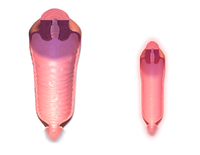
Photo from wikipedia
PURPOSE MRI-guided cervical cancer brachytherapy provides unparalleled soft-tissue contrast for target and normal tissue contouring, but eliminates the ability to use conventional metallic fiducials for radiation source path reconstruction as… Click to show full abstract
PURPOSE MRI-guided cervical cancer brachytherapy provides unparalleled soft-tissue contrast for target and normal tissue contouring, but eliminates the ability to use conventional metallic fiducials for radiation source path reconstruction as required for treatment planning. Instead, the source path is reconstructed by manually aligning a library model to the signal void produced by the applicator, which takes time intra-operatively and precludes fully-automated treatment planning. The purpose of this study is to present and validate an algorithm to automatically reconstruct tandem and ring applicators using MRI for cervical cancer brachytherapy treatment planning. METHODS Applicators were reconstructed using T2-weighted MR images acquired at 1.5 T from 33 brachytherapy fractions including 10 patients using a model-to-image registration algorithm. The algorithm involves 1) image filtering and maximimum intensity projection to highlight the applicator, 2) ring center identification using the circular Hough transform, and 3) three-dimensional surface model registration, optimized by maximizing the image intensity gradient normal to the model surface. Two independent observers manually reconstructed all applicators, enabling the calculation of inter-observer variability and establishing a ground truth. Algorithm variability was calculated by comparing algorithm results to each individual observer, and algorithm accuracy was calculated by comparing algorithm results to the ground truth. The algorithm variability and accuracy were compared to the inter-observer variability using paired t-tests. RESULTS Mean ±SD inter-observer variability was 0.83±0.31 mm and 0.78±0.29 mm for the ring and tandem, respectively. The algorithm had mean ±SD variability and accuracy of 0.72±0.32 mm (p=0.02) and 0.60±0.24 mm (p=0.0005) for the ring, and 0.70±0.29 mm (p=0.11) and 0.58±0.24 mm (p=0.004) for the tandem, respectively. CONCLUSIONS The algorithm variability and accuracy were within the inter-observer variability measured in this study. The algorithm accuracy and mean execution time of 10.0 s are sufficient for clinical tandem and ring reconstruction, and are a step towards fully automated tandem and ring brachytherapy treatment planning. This article is protected by copyright. All rights reserved.
Journal Title: Medical physics
Year Published: 2019
Link to full text (if available)
Share on Social Media: Sign Up to like & get
recommendations!